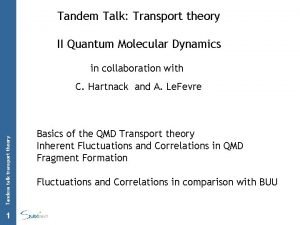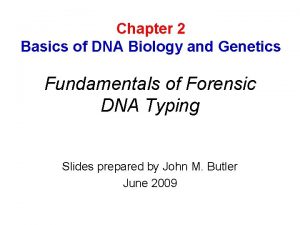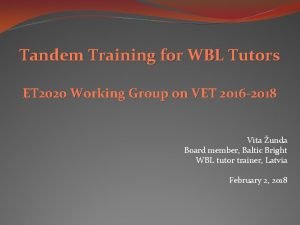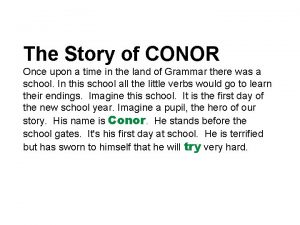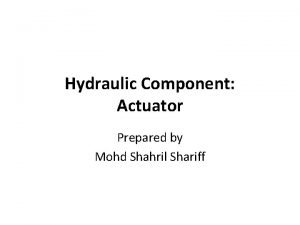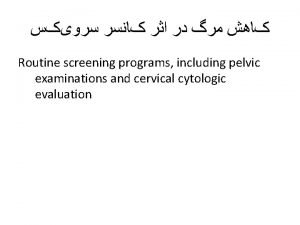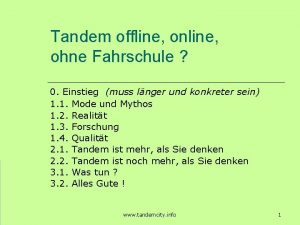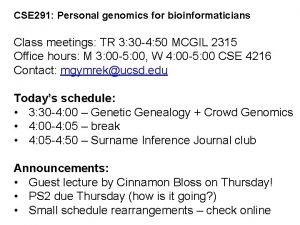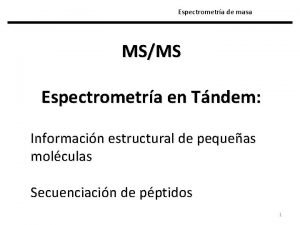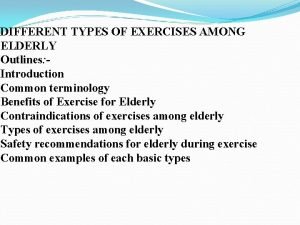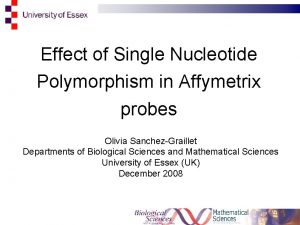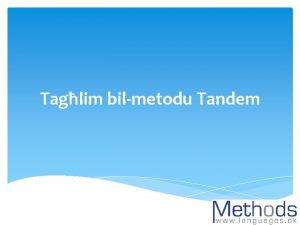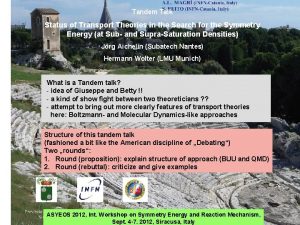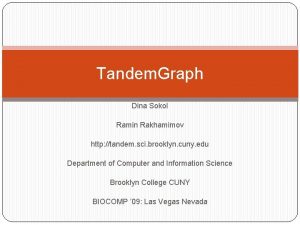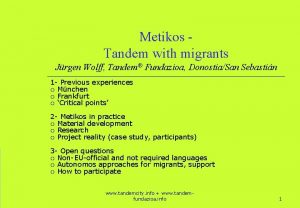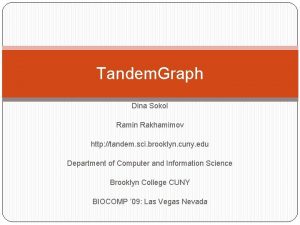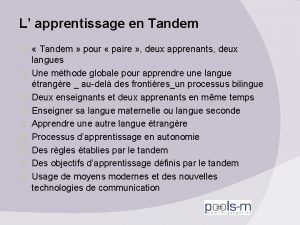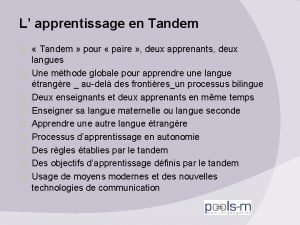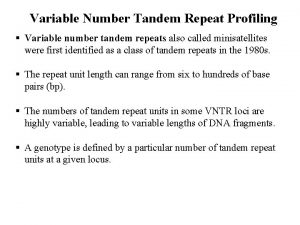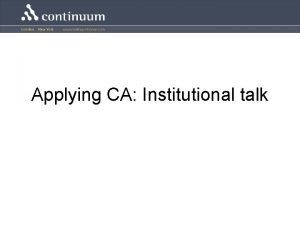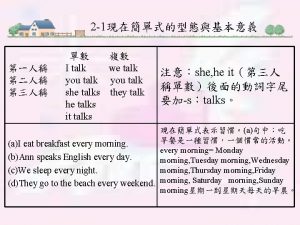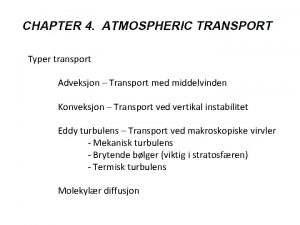Tandem Talk Status of Transport Theories in the






























- Slides: 30

Tandem Talk Status of Transport Theories in the Search for the Symmetry Energy (at Sub- and Supra-Saturation Densities) Jörg Aichelin (Subatech Nantes) Hermann Wolter (LMU Munich) What is a Tandem talk? - idea of Giuseppe and Betty !! - a kind of show fight between two theoreticians ? ? - attempt to bring out more clearly features of transport theories here: Boltzmann- and Molecular Dynamics-like approaches Structure of this tandem talk (fashioned a bit like the American discipline of „Debating“) Two „rounds“: 1. Round (proposition): explain structure of approach (BUU and QMD) 2. Round (rebuttal): criticize and give examples ASYEOS 2012, Int. Workshop on Symmetry Energy and Reaction Mechanism, Sept. 4 -7. 2012, Siracusa, Italy

Levels of description of heavy ion collision from initial to final state: initial final thermal expansion hydrodynamics transport theory Statistical models, e. g. SMM, Botvina, et al. Statistical emission in expanding system, e. g. EES, Friedmann Hydrodynamical model, e. g. Stöcker, Maruhn, et al. Transport models, e. g. BUU, QMD, AMD, etc Transport approaches essential if system is not always in equilibrium. Many observbles are determined during the evolution and not only at the end. Especially interesting questions, like the high density phase, occur when the system is still not equilibrated.

Transport Theories: Evolution of a colliding many body system Boltzmann-like approaches: Evolution of 1 -body phase space densitiy with dissipation, i. e. collisions Molecular Dynamics approaches: evolution of many body system under the influence of two- (or more-) body interactions. Both can be understood as starting from classical descriptions and by introducing quantum features: Statistics: Fermion statistics, Pauli Principle à Collisions and Fluctuations Fragment formation connected to fluctuations Collisions and fluctuations affect the dynamics of a collision: - both 1 -body and many-body observables -Thus they also influence isospin dependent observables and the determination of the density dependence of the Symmetry Energy. - However, BUU and QMD analyses often give different results Aim of this tandem talk: Bring out the role of collisions and fluctuations in BUU and QMD transport appraoches. àUnderstand the uncertanties in the extraction of isospin observables connected to the transport approach (not the model input!) NOT to discuss present status of knowledge of symmetry energy, etc

Classical derivation of a BUU transport equation then or generally in a potential U(r): (Vlasov equ. ) Rgain 1 -dim dv phase space density is constant in time (Liouville theorem), velocity v central quantitiy: 1 -body phase space distribution: probability to find at time t a particle if type i at point r with momentum p dx position x Rloss drift term acceleration by the field BUU eqn. 3 4 Collisions will change the phase space density! correspondingly gain 1 Pauli principle: blocking factors energy momentum conservation: Collision term added „by hand“ Relation of mean field U and medium cross section s not clear. 2 more ways to arrive at the BUU eqn. which highlight ist properties 2

Quantum Derivation of Vlasov Equation (see e. g. Bertsch) Start with TDHF Wigner transform Equation of motion for Wigner transform f. Use gradient approximation for Wigner transform of products again Vlasov eq. Remarks: • 1 st order grad. expans. gives a classical eq. , since lhs already contained a term ~ • collision term has to be added „by hand“ as before • quantum statistics only contained in initial condition, but is preserved by the evolution (Liouville theorem; for coll. term explicitely via blocking terms) • f(r, p) is a quantum object, and not positive definite! • Can easily be done in a relativistic formulation (RMF)

Non-equilibrium Transport Theory (Kadanoff-Baym) To derive a collision term consistently, one has to include the non-equilibrium L. P. Kadanoff, G. Baym, Quantum statistical mechanics, 1965 features of the process P. Danielewicz, Ann. Phys. 152 (1984) 239 O. Buss, T. Gaitanos, … U. Mosel, Phys. Rep. 512 (2012) 1 Hierarchy of n-body Green functions (Martin-Schwinger hierarchy) (Dyson eq. ) decouple formally via the self energy S, or by an approximation to it, e. g. BHF C(+) C(-) Re t The GF‘s are defined on a closed time-contour (Schwinger-Keldysh). All quantities become 2 x 2 matrices. In non-equilibrium there are two independent 1 -body Green functions (GF), since the propagation forward and backward in time is different. F generalized occupation A spectral function Wigner transform, Lorentz decomposition (scalar, vector, tensor), gradient expansion of products Kadanoff-Baym equations: Kinetic term mean field term „back-flow“ term collision term

Self Energy Approximation Quasi-particle approximation (QPA) A spectral function QPA reduces no. of variables from 8 to 7 particle interpretation possible The self energy is taken in the T_Matrix approximation, including exchange and twobody correlations: the Brueckner HF theory. T T àNow the collision term appears consistently and is obtained on the same footing from the Brueckner T-Matrix. à off-shell extension (particles with widths) clear (Buss et al. , ) non-equlibrium effects in T-Matrix possible (e. q. 2 -Fermi sphere approximation; Fuchs, Sehn, HHW)

Testparticle Solutions of BUU Equation non-linear integro-differential equation, no closed solutions - but deterministic ! a) solution on a lattice: has been used for low-dimensional model systems, but too expensive for realistic cases b) b) test particle method (Wong 82) where are the positions and momenta of the TP as a funct. of time, and NTP is the number of TP per nucleon (usually 50 – 200) approximate a (continuous) phase space distribution by a swarm of d-functions variant: Gaussian TP: smoother distribution with fewer TP if , exact solution of BUU eqn. ! ansatz into Vlasov eq. Hamiltonian equations of motion: the rhs (collision term) is simulated, stochastically; 2 methods: full ensemble: collide TP with scaled s. TP=s/NTP parallel ensemble: divide into NTP ensembles and collide particles average phase spaced distribution over ensembles after each time step not very different, but saving of computer time describes average effect of collisions ( dissipation), BUT NO Fluctuations

Fluctuations in Phase Space Mean field evolution Fluctuations (higher orger correlations) (dissipative) Boltzmann-Langevin eqn. govern evolution in stable region dominant in Instable regions General principle: Brownian motion with friction and random force R(t) Fluctuation-Dissipation theorem (Einstein relation) àDissipation (collisions) and Fluctuations necessarily connected!

Fragment formation in transport descriptions However, the BUU equation is an equation for the 1 -body distribution function: Fragments, however, need information on the joint probabilities of several particles. i. e. many-body correlations. This can, in principle not be obtained from the solution. Where was this information lost in the derivation? Martin-Schwinger hierarchy of coupled Green fcts. is truncated (formally) by introduction of self energy S This neglects higher order correlation effects They have to reintroduced in the form of fluctuations. Origin of fluctuations: initial state correlations (how important and realistic? ) higher order correlations collisions (diss. -fluct. theorem) The last two are not contained in BUU and have to be reintroduced, i. e. the Boltzmann-Langevin eq. has to be solved, at least approximatively Now Jörg about QMD


Second round

Rebuttal: BUU is appealing method for the following reasons: Derivable from non-eq. many body theory (Kadanoff-Baym) àRelation mean field U to medium cross sect. smed clear (e. g. BHF) àextensions possible: off-shell effects (particles with finite width, complex self energy) relativistic formulation, field theory àNumerically exact solution exists, NTP infinity BUT: no fluctuations, only average effect of collisions dissipation violates dissipation-fluctuation theorem Origin of fluctuations: 1. 2. 2. 3. 3. 4. 5. Initial state correlations: probably not very important. Initial state wafe functions not very realistic Higher order correlations cut-off by truncation of G-matrix hierarchy; present in QMD but averaged out partially and empirically by widths of Gaussians Effect of collisions QMD moves one particle large fluctuation in phase space (depending on width of particle BUU moves one TP, small effect, fluct of f Fluctuations have to be introduced to BUU 1. Replace BUU by BL eq. 2. 3. Increase effect of collisions treatment of collision term important

Implementations of BL Equation Ref. : Abe, Ayik, Reinhard, Suraud, Phys. Rep. 275, 49 (96) Exact studies (on a lattice) only in 2 D: Randrup, Burgio, NPA 529 (1991) Approximate methods: 1. Numerical fluctuations: gauge numerical fluctuations to instability of most unstable mode: Colonna, Di. Toro, . . 2. BOB: replace fluctuation term by fluctuating force, gauged to most unstable mode Colonna, Guarnera 3. Stochastic MF dynamics: introduce locally statistical fluctuations ito the phase space distribution at certain times s 2=f(1 -f): Colonna, Di. Toro, …Wolter 4. „Bertsch method“ (recently developed by M. Colonna, P. Napolitano): with one TP collision move NTP TP near in phase space, to simulate collisions of nucleons. for most unstable mode k=6 diff. no. of TP exact Colonna, et al. , PRC 47 (93) from BL eq: assume stat. equil locally Implementation: - project s 2 eq on density fluctuations - inject fluctuation in each coordinate space cell at time interalls Dt - choose Dt consistent with growth time of instabilities

Fragment recognition in BUU: 1. „density cut“: find contours of density rc ~1/10 r 0 Fragments have non-integer mass and charge numbers. Distribute to neighboring integer masses. 2. Test particle distribution sampling: 3. choose A out of NTP*A test particles with correct global properties. Treat these as nucleons and do coalescence or MST algorithm (or SACA (as in QMD): two particles belong to the same cluster if their distance in phase space is below a limit r 12<r 0, p 12<p 0; r 0, p 0 parameters Do this many times (~1000), and generate a distribution. 2. Construct many body correlations consistent with the single particle distribution Ex. : 4 „events“ with fluctuations

Fragment recognition in BUU: 1. „density cut“: find contours of density rc ~1/10 r 0 Fragments have non-integer mass and charge numbers. Distribute to neighboring integer masses. 2. Test particle distribution sampling: 3. choose A out of NTP*A test particles with correct global properties. Treat these as nucleons and do coalescence or MST algorithm (or SACA (as in QMD): two particles belong to the same cluster if their distance in phase space is below a limit r 12<r 0, p 12<p 0; r 0, p 0 parameters Do this many times (~1000), and generate a distribution. 2. Construct many body correlations consistent with the single particle distribution Ex. : 4 „events“ with fluctuations

Code Comparison Project: Workshop on Simulations of Heavy Ion Collisions at Low and Intermediate Energies, ECT*, Trento, May 11 -15, 2009 using same reaction and physical input (not neccessarily very realistic, no symm energy)) included major transport codes obtain estimate of „systematic errors“ Name Code References Eo. S(hw 1) Eo. S (hw 2) Ono AMD PRC 66(02)014603 own Eo. S Hartnack IQMD EPJA 1(98)151 prescribed Napolitani BQMD PR 202(91)233 prescribed own Eo. S Zhang Im. QMD PLB 664(08)145; PRC 71 (05)024604; PRC 74(06)014602 prescribed Danielewicz BEM - prescribed Q. -F. Li Ur. QMD PRC 73(06)051601; JPG 32(06)151 prescribed Giordano BNV (CT) NPA 732(04)202; PRC 72(05)064609 prescribed Pfabe BNV NPA 732(04)202 prescribed Gaitanos RBUU(Munich) NPA 714(03)643; NPA 741 (04) 209 prescribed Gi. BUU (SK) BUU-Giessen gibuu. physik. uni-giessen. de prescribed Gi. BUU (RMF) RBUU-Giessen PLB 663(08)197; ar. Xiv: 0904. 2106 v 1; PRC 76(07)044909 prescribed B. -A. Li, G. C. Yong IBUU PR 160(88)189; PRC 44(91)450 & 2095. prescribed Schade BUU ? ? prescribed

Some results of comparison Transverse flow Correlation between transv flow and Vartl (ratio of long and transv stopping) Distribution in longitudinal (z) and transverse (y) direction (stopping) correlation equilibration Even though differences appear small, consider that in the SE we are looking at 10% effects.

Distributions of collision: Store collision energies, times, density of the environment, blocking (solid: all, dashed: unblocked) energy of the collison (time integrated) Time of the collision (energy integrated) Big differences in collision histories between programs. Effect on observables that depend on collisons, like particle production? Spread of programs is still too large !!

Comparison of simulations: SMF-AMD: Ref. : Rizzo, Colonna, Ono, PRC 76(2007); Colonna et al. , PRC 82 (2010) SMF (BGBD) 112 Sn+112 Sn, 50 AMe. V AMD Stopping: similar Radial density at different times: SMF more bubble like SMF Averaged density and momentum fluctuation (in z-direction) as fct of time AMD

Effect on isospin observables (M. Colonna, et al. , PRC 82 (2010) IMF multiplicities emitted neutrons/protons Z>2 (dash) A<16 SMF (green) AMD (black) Z>6 (solid) neutrons A<5 protons A<5 Accelaration of fragments from t=200 600 fm/c AMD more clustered Asy-soft (dashed)/asy-stiff (solid) little difference AMD SMF Difference in isospin observables in two methods due to different amounts of fluctuation SMF source more compact

Analysis of differences SMF – QMD (M. Colonna, GRC 2011 and NN 2012 conf) d<Z>/dy (per event) à more `explosive´ dynamics: more `transparency´ 6 fm 8 fm γ = 0. 5 Y. Zhang et al. , ar. Xiv: 1009. 1928 d<N/Z>/dy (per event) SMF = dashed lines Im. QMD = full lines γ=2 γ = 0. 5 Much less isospin migration in Im. QMD, Other sources of dissipation: Fragment emission, fluctuation? SMF Less dependence on impact parameter. Similar conclusions in comparison with Antisymmetrized Mol. Dynamics (AMD): Colonna, Ono, Rizzo, PRC 82 (2011) Model dependence of imbalance ratio!

BUU(BNV)/SMF QMD/AMD Comparison Mean field evolution very similar! Semiclass approx to TDHF Solved with inf. no. of TP TD-Hartree with product wf of sp Gaussians of large width (AMD TDHF) Collision term and med cross sect similar in principle, often not implement Consistently derivable from KB approach, good approx. BHF collisions full ens. : TP coll small fluct parall. ens. : average after each timestep, same àToo little fluct by collision, only av. dissip. (improve: Bertsch method (Colonna): move NTP TP) Not consistently derivable but empirically the same, Main diff of different effect of collisions approaches collide particles àGenerates large fluct in phase space depending on width of Gaussian affects also Pauli blocking Fluctuations diff mainly by effect of collision term Inital state correlations, similar, initial wf not realistic BUU eq. should be replaced by Boltzmann-Langevin eq. higher order corr due to localized (packet) wf but averaged out by smearing Fragment formation and recognition Fluct as seeds of fragments, amplified by mf, (at least for not too large inc. energy. ) Early/late recognition does not affect dynamics; a-posteriori Can implement TP sampling and thus also MST, SACA, etc methods MST, SACA/ECRA methods natural Small clusters (d, t, 3 He, a) not well described in both approaches (better in AMD) Best treated explicitely (but include a!)

backup

Comparison SMF-Im. QMD M. Colonna, GRC 2011 6 fm 8 fm γ = 0. 5 SMF = dashed lines Im. QMD = full lines Ø For semi-central impact parameters: Larger transparency in Im. QMD (but not so a drastic effect) Other sources of dissipation (in addition to nucleon exchange) More cluster emission SMF Ø Isospin transport R around PLF rapidity: Good agreement in peripheral reactions Im. QMD Elsewhere the different dynamics (nucleon exchange less important in Im. QMD) leads to less iso-equilibration What about fragment N/Z ? No isospin migration in Im. QMD ! γ=2 γ = 0. 5

VI. 2 Evidence of Phase Transitions in Calculations BNV calculation in a box (periodic bounday conditions) with initial conditions in side the instability region: r=r 0/3, T=5 Me. V, b=0 Formation of „clusters (fragments)“, starting from small (numerical“ fluctuations in the density. Time scale shows the growth time of the instable modes other example as fct. of initial density Mean field amplifies density fluctuations in instable region. Cruscial however, is the „seed“ distribution! Here only numerical. Determine physically! t=0 fm/c t=100 fm/c t=200 fm/c


Stochastic Mean-Field Transport approach (SMF) Colonna, et al. , NPA 642 (1998) Boltzmann-Langevin: fluctuations Markov assumpt. from BL: Equilibrium in a phase space cell Implementation: - project s 2 eq on density fluctuations - inject fluctuation in each coordinate space cell at time interalls Dt - choose Dt consistent with growth time of instabilities

Ratios of emitted pre-equilibrium particles Early emitted neutrons and protons reflect difference in potentials in expanded source, esp. ratio Y(n)/Y(p). protons vs. neutrons 124 Sn + 124 Sn 112 Sn + 112 Sn more emission for asy-soft, since symm potential higher „Double Ratios“ 124 Sn + 124 Sn 112 Sn + asy-soft asy-stiff softer symmetry energy closer to data Data: Famiano, et al. , PRL 06 asy-soft asy-stiff qualitatively as seen in Im. QMD, but quantitatively weaker dependence on Sym. En SMF simulations, V. Baran 07 Y. Zhang, et al. , ar. Xiv (2011)

Summary: Boltzmann approaches: Derivation: classical, semiclass q. m. w/o collision term non-eq. theory: mf + collision cross sect consistent (e. g. BHF approx. ) BUU eq. deterministic, no fluctuations solved exactly in TP method with NTP infinity but only av. Effect of collisions, NO fluctuations Fluctuations: seeds for fragment formation origin from initial state correlations, collisions and higher order correlations (not BUU) have to be reintroduced in a physical way (i. e. BL equation should be solved) Fragment formation fluctuations as seeds of fragments (amplified by mf in regions of instability) Fragment recognition: does not influence dynamics but interpretation of results. diff methods should (and do) give same results asymptotically Influence on isospin observables T-matrix isospin dependent short range isospin behavior uncertain (tensor force) HD symm energy fluct and fragment formation influence isospin transport
 Tandem talk
Tandem talk Talk, read talk write template
Talk, read talk write template Amateurs discuss tactics professionals discuss logistics
Amateurs discuss tactics professionals discuss logistics Problem talk vs solution talk
Problem talk vs solution talk Active vs passive transport venn diagram
Active vs passive transport venn diagram Active transport image
Active transport image Primary vs secondary active transport
Primary vs secondary active transport Pinocytosis vs phagocytosis
Pinocytosis vs phagocytosis Isotonic in biology
Isotonic in biology Primary vs secondary active transport
Primary vs secondary active transport Primary active transport vs secondary active transport
Primary active transport vs secondary active transport Now answer the questions
Now answer the questions Bioflix activity membrane transport active transport
Bioflix activity membrane transport active transport Short tandem repeat
Short tandem repeat Tandem become a tutor
Tandem become a tutor Mercator tandem proficisci constituit
Mercator tandem proficisci constituit Tandem technique in ultrasonic testing
Tandem technique in ultrasonic testing Lefle
Lefle Gambar actuator silinder double action
Gambar actuator silinder double action Tandem walking exercise
Tandem walking exercise Tandem
Tandem Tandem language
Tandem language Brachytherapy
Brachytherapy Tandem offline
Tandem offline Short tandem repeats
Short tandem repeats Tndem
Tndem Tandem walking exercise
Tandem walking exercise Short tandem repeat
Short tandem repeat Short tandem repeat
Short tandem repeat üre sentezi
üre sentezi Ic camigliano
Ic camigliano
